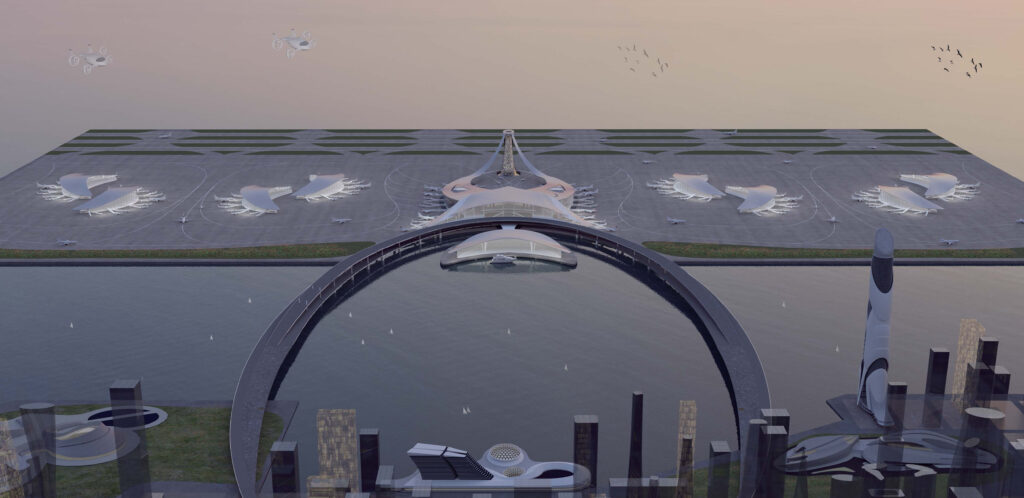Following an extremely competitive selection process, Fentress Architects has announced the design partnership of Ferreras + Osiberu as the winner of its 2021 Fentress Global Challenge (FGC) Airport of the Future.
The competition was launched in 2011 by Curtis Fentress, principal in charge of design at Fentress Architects. This year’s FGC had more than 80 entries from students around the world who were challenged to envision airport mobility in the year 2100. Entrants could site their new terminals at a selection of existing airfields or undeveloped sites.
Various modes of transportation were explored, including pods for intra-airport runs, maglev cars, drones, hyperloops, hydrofoils and air-rails. Furthermore, several types of aircraft were studied, including anti-gravity, vertical take-off, rockets and spaceships.
Commenting on this year’s entries, Curtis Fentress said, “Passion for design and a creative mindset are the cornerstone of any successful design competition. Each year, the submissions we receive are more innovative, sustainable and dynamic than the previous year, which reveals an exciting outlook for the future of terminal design.”
1st place (Prize money: US$15,000)
Ferreras + Osiberu – Yokohama International Airport (new-build)
Carmina Ferreras and Oluwarotimi Osiberu are third-year master of architecture students at North Carolina State University. Ferreras is a former high-school math teacher who is interested in connecting communities through advances in technology and sustainability. Oluwarotimi moved to the USA in 2009 from Nigeria, and is interested in spaces that foster healthy communities.
The pair’s entry imagines a new airport in Yokohama, Japan, to help alleviate congestion at Tokyo International Airport. The new hub is designed to serve hypersonic, subsonic and vertical take-off and landing (VTOL) flights that will access the furthest corners of Earth. As a multimodal facility, it also incorporates high-speed rail systems linking land, sea and air. Concourses feature vast, traditional gardens and views of marine wildlife. Walk-through security and facial recognition scan passengers to create a seamless airport experience. An internal tram system moves passengers throughout the facility and offers views of gardens and nearby Mount Fuji.
2nd place (Prize money: US$3,000)
Liyang Wang – AILY – Coralífera Maritime Airport, Atafu, Tokelau (new-build)
A student at the Yale School of Architecture, Wang imagined an airport in the northern corner of the island of Atafu in Tokelau in the southern Pacific Ocean. It uses a series of solar-powered runways and devices that move to accommodate airplane operations. The airport also helps grow and then transplant coral from a nursery to reefs below. Travelers can observe the process, which will help cultivate climate awareness. Floating people-mover pods are used to transport visitors to and from the island.
3rd place (Prize money: US$2,000)
Tan Gee Yang, Adaptive Antifragile – Singapore Changi Airport T5 (existing airfield)
Yang, a student at Singapore University of Technology and Design, chose to reimagine Terminal 5 at Singapore Changi Airport. This entry envisions a reconfigurable and dynamic airport that uses data and machine learning to reconfigure itself in response to demand. Passengers such as business travelers or vacationing families will be routed in unique directions to fit their specific needs. Reconfigurable pods will accommodate new retail experiences, attractions and rest areas.
People’s Choice Awards (Prize money: US$1,000 per award)
Of the two People’s Choice Awards voted for by the public this year, one went to Ferreras + Osiberu for Yokohama International Airport, and the second went to Assem Attia, a student at the University of Architecture, Civil Engineering and Geodesy in Sofia, Bulgaria, for ‘The Future Cell’. This airport design, set at Dubai International Airport in the UAE, is based on Voronoi diagrams and is inspired by patterns from the natural world. Greenery has been integrated into the buildings, and VTOL aircraft depart from compartmentalized platforms.
Other shortlisted entries for 2021
- Urban Travelator – Dinel Meyepa – Monash University, Melbourne, Australia
- Decentralized Airport – Dinh Hoang Tam – University of Architecture, Ho Chi Minh City, Vietnam
- Synergistic Airport – Baoqi Xiao – University of Southern California, Los Angeles, California, USA
- Astra – Jonathan Liang & Martin He – Columbia University, New York City, USA
- AJQ Group – Qian Yu, Alexandra Terekhova and Joseph Cook – University of Applied Arts, Vienna, Austria
- The Heathrow Hive – Jack Hastie – University College London, UK
Judging panel
The entries were evaluated on five criteria: creative approach and presentation, response to site, sustainability and resiliency, functionality, and innovation and technology. The jury of aviation professionals included:
- Blake Scholl, founder and CEO of Boom Supersonic
- David Laielli, senior technical architect for airport terminal buildings at AECOM
- Melvin Price, associate principal and global ORAT specialist with Jacobs
- Dan Bartholomew, airport director at Aspen/Pitkin County Airport
-
Dan Symonds, online editor of Passenger Terminal World

